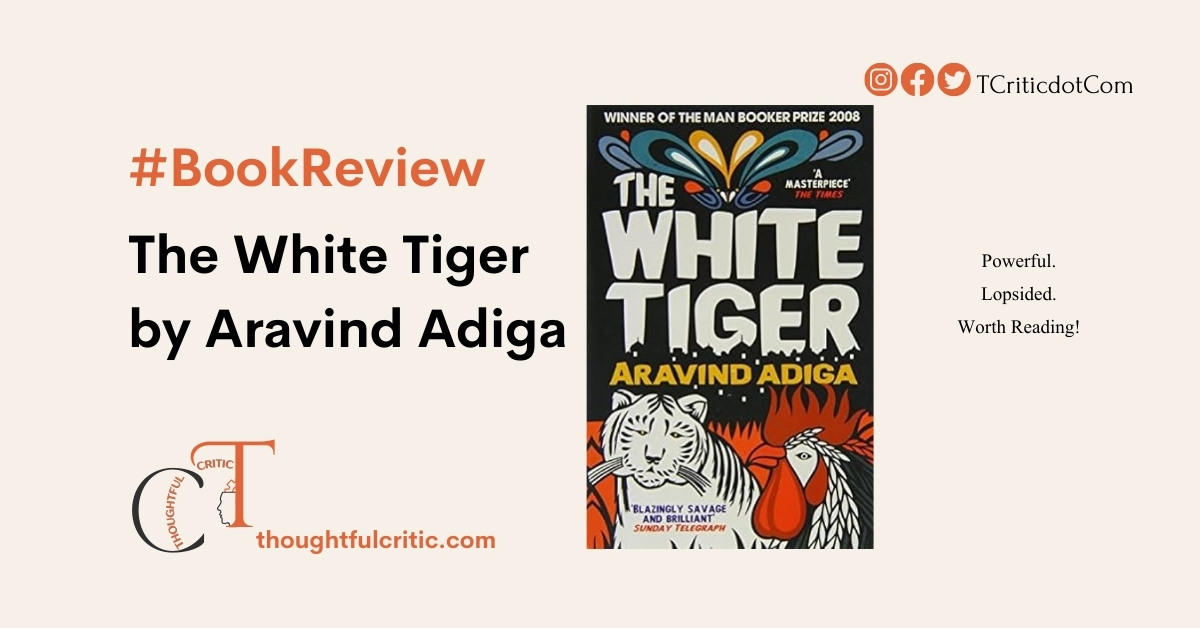Title: The White Tiger
Author: Aravind Adiga
Publisher: HarperCollins India (2008)
Language: English
Format: Paperback, 321 pages
If you don’t know already, Adiga’s The White Tiger is a bestselling novel that won him the prestigious (really?) Man Booker Prize in 2008. The story offers many things – ideas, opinions, satire, humour, absurdity, surrealism, and more. Though the novel proposes two sides of India, there are many loopholes in the storytelling that many critics have cited. In this book review, I will analyse many things about the novel. I hope you enjoy reading this article.
Let’s begin with a formal introduction. Aravind Adiga’s The White Tiger presents a gritty depiction of contemporary India through the lens of Balram Halwai, a driver from rural poverty who aspires to break free from the constraints of the caste system and social exploitation. Set in modern-day India, this Booker Prize-winning novel explores the socio-economic divides with a critical and satirical edge, reflecting Adiga’s attempt to expose the underlying tensions of India’s capitalist progression. Adiga’s ambitious yet controversial approach to representing India through starkly polarised perspectives has been widely discussed in literary circles. While the novel is undeniably thought-provoking, it faces criticism for oversimplifying India’s multifaceted social structure, portraying a one-dimensional view of a rapidly evolving nation.
Plot Summary
The story follows Balram Halwai, born into poverty in a village called Laxmangarh. His journey takes him from the rural backwaters to the bustling streets of Delhi and beyond as he transitions from a servant to a morally ambiguous entrepreneur. Written as a series of letters addressed to the Chinese Premier, the narrative allows Balram to recount his rise to wealth and freedom, primarily driven by a pivotal act of violence that shifts the course of his life. As Balram confronts the profoundly entrenched class inequalities and corrupt systems governing Indian society, he exposes the brutality required to survive and the darkness within the aspirational “Great Indian Dream.”
Narrative Style and Structure
Adiga employs a unique epistolary form for the narrative, which provides Balram with a platform to express his philosophy while exposing his worldview to the reader. This choice of structure, however, while allowing a fluid and unrestricted inner monologue, also presents certain limitations. Balram’s monologue-driven account shapes an unfiltered narrative style but restricts the exploration of nuanced viewpoints from other perspectives. While the stream-of-consciousness style captures Balram’s psychological depth, the lack of contrasting voices in the novel often results in a subjective portrayal that can appear more opinionated than balanced, inadvertently skewing the reader’s perception of India.
Characterisation and Development
Balram Halwai, as the protagonist and narrator, embodies Adiga’s critique of India’s socio-economic stratification. His morally complex character—neither entirely a hero nor an antihero—serves as a conduit for Adiga’s commentary on ambition, morality, and the nature of servitude. However, the supporting characters, particularly those representing the elite class, tend to fall into stereotypes, lacking the depth and individuality that could have provided a more nuanced exploration of social disparity. Characters like Ashok, Pinky Madam, and other members of the wealthy “masters” class are often depicted through predictable tropes, rendering them less as authentic figures and more as symbols of social and moral degradation.
This limited characterisation restricts the novel’s scope, as it reduces the Indian socio-economic hierarchy to a simple binary of exploiters and exploits. Thus, the complexities of India’s socio-political structure are simplified, sidelining those diverse middle and working classes whose experiences offer equally significant perspectives on contemporary India. Adiga’s oversimplification diminishes the multifaceted nature of Indian society, presenting an image of a deeply divided country without the intricacies that underlie real-world relationships between different social strata.
Themes and Social Commentary
Thematically, The White Tiger tackles significant issues such as corruption, poverty, class oppression, and the aspirations of the underprivileged. Balram’s ascent from servant to self-made man is presented as a byproduct of ambition and desperation in a society where moral compromise appears as the only feasible path to success. Adiga addresses the pervasive influence of globalisation on India’s social fabric, critiquing the disparity between urban affluence and rural impoverishment. Yet, Adiga’s treatment of these themes, though impactful, often leans towards a pessimistic portrayal of India, as if defining it solely by its corruption, violence, and caste barriers.
While resonating with readers seeking a critical view of India’s systemic flaws, such representation risks reducing India’s complex realities into a narrow portrayal. While the novel brings attention to urgent social issues, it overlooks the progressive changes and cultural richness that coexist alongside these challenges. Consequently, Adiga’s India emerges as a caricatured dystopia, devoid of its subtler, often contradictory, layers of social resilience, adaptation, and coexistence.
Language and Style
Adiga’s language is lucid yet gritty, capturing Balram’s raw, unfiltered perspective and intensifying the novel’s aggressive tone. The language often borders on cynical, even jarring, reflecting the bitter disillusionment of an individual trapped in a cycle of oppression. Adiga’s use of humour, though dark and satirical, remains incisive and serves as a vehicle to convey Balram’s jaded social observations. This linguistic approach effectively captures the protagonist’s voice but can sometimes come across as overly coarse, reinforcing a stereotyped vision of India.
The portrayal of India as a “jungle,” where survival is predicated on brutality, may resonate with Western readers seeking a sensationalised view of the country but risks alienating those familiar with India’s complex social realities. Adiga’s stylistic choice to keep the narrative bare and direct effectively drives home his critique. Still, it often lacks the lyrical quality that could offer readers moments of introspection and empathy, leaving the prose excessively bleak.
Critical Analysis
The White Tiger stands as a compelling social critique that brings pressing issues within Indian society to the forefront. Adiga’s narrative demonstrates his commitment to depicting marginalised communities’ struggles and the upper class’s hypocrisies. However, the novel’s unrelenting focus on the dark side of India risks reinforcing an oversimplified view of the country. By favouring stark contrasts between rich and poor, moral and immoral, Adiga’s portrayal reduces the complexities of India’s evolving social landscape to a binary conflict, neglecting the myriad shades of resilience, diversity, and hope that is equally central to the Indian experience.
While The White Tiger has been lauded for its boldness and raw honesty, it has also been criticised for pandering to Western preconceptions about India as a poverty-stricken, corrupt nation. The lack of middle-ground representation regarding socio-economic class and moral standpoint ultimately weakens the novel’s capacity for genuine social critique, as it foregoes the voices of those striving to build a balanced, modern India amid the challenges. Adiga’s lens, though powerful, limits itself to one part of a much larger story, reducing the broader narrative of India’s journey.
Should you read it?
Of course! Adiga’s book is a powerful piece of contemporary fiction. It would help if you read it to understand how a few novelists portray India according to their singleton beliefs, perceptions, and views from the ‘outside’. Adiga represents all the authors who may see only ‘heat and dust’ in India. You can get a copy of this novel from Amazon India, perhaps at a discounted price, here: Get your copy now – click here.
More
You can read these articles to understand more about Adiga as a novelist and various perspectives on his work The White Tiger.
Aravind Adiga – a detailed biography, critical analysis of his writing, approach and more
Conclusion
Aravind Adiga’s The White Tiger is an evocative, provocative, and sometimes uncomfortable portrayal of contemporary India. While its thematic exploration of ambition, corruption, and social disparity resonates with readers, its narrow focus and reliance on stereotypes risk perpetuating a limited view of Indian society. This novel may be insightful for readers interested in social criticism and raw depictions of marginalised communities, as it captures the struggles and bitterness of India’s oppressed. However, The White Tiger may seem reductive and overly cynical for those seeking a more nuanced and balanced portrayal. The novel’s literary merits are evident, yet its shortcomings in portraying the intricacies of India’s social fabric mark it as a work that, while significant, should be approached with an awareness of its limitations.
Vyom for Thoughtful Critic
The White Tiger by Aravind Adiga Book Review
-
Critical Rating
Summary
Powerful.
The narrative, however, falls short. Adiga might have lost control and could not observe realism mutating into surrealism.




